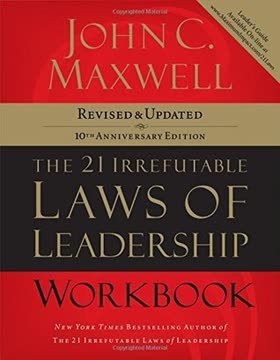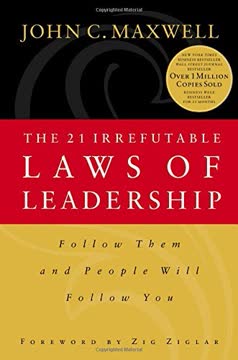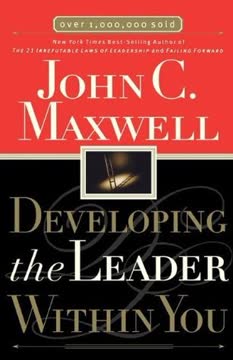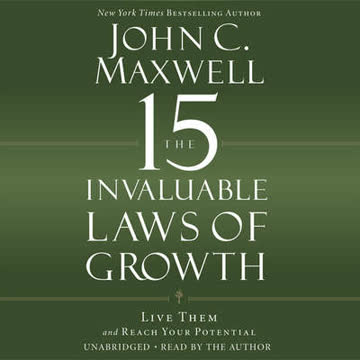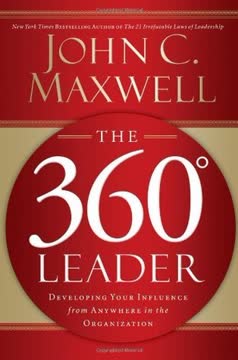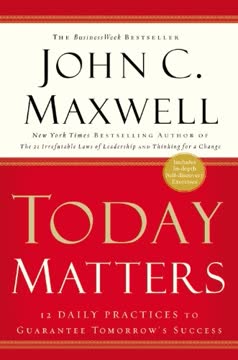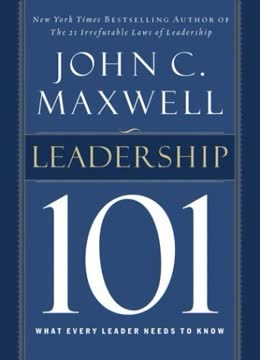Key Takeaways
1. Leadership is Influence, Not Position
If you can't influence people, then they will not follow you. And if people won't follow, you are not a leader.
Leadership is about impact, not title. True leadership stems from the ability to influence others, regardless of one's official position. This influence is earned through character, competence, and relationships, not bestowed by rank or title.
Effective leaders:
- Build trust and credibility with their actions
- Inspire and motivate others to follow willingly
- Lead by example, not just authority
- Cultivate relationships at all levels of the organization
Leadership influence extends beyond formal authority, allowing leaders to drive change and achieve results through others, even without direct control.
2. Effective Leaders Develop Daily, Not in a Day
Leadership develops daily, not in a day.
Leadership is a continuous journey of growth and improvement, not a destination reached overnight. Successful leaders commit to ongoing personal development, consistently honing their skills and expanding their knowledge.
Key practices for daily leadership development:
- Regular reading and study of leadership principles
- Seeking feedback and learning from experiences
- Reflecting on successes and failures
- Setting personal growth goals and tracking progress
- Surrounding oneself with mentors and growth-oriented peers
This daily commitment compounds over time, gradually transforming good leaders into great ones. The most influential leaders are lifelong learners who embrace the process of continuous improvement.
3. Leaders Must Navigate and Chart the Course
Anyone can steer the ship, but it takes a leader to chart the course.
Effective leadership requires vision and strategy. Leaders must not only manage day-to-day operations but also provide clear direction for the future. They anticipate challenges, identify opportunities, and develop plans to guide their team or organization toward success.
Key aspects of leadership navigation:
- Defining a compelling vision
- Setting clear, achievable goals
- Anticipating obstacles and preparing contingencies
- Communicating the plan effectively to all stakeholders
- Adjusting course as needed while maintaining overall direction
Leaders who excel at navigation inspire confidence in their followers, provide a sense of purpose, and enable their teams to overcome challenges and achieve ambitious objectives.
4. True Leaders Add Value by Serving Others
Leaders add value by serving others.
Servant leadership is transformative. The most effective leaders focus on adding value to their team members, prioritizing the growth and well-being of those they lead over their own interests. This approach fosters loyalty, engagement, and high performance.
Ways leaders can serve and add value:
- Mentoring and developing team members
- Removing obstacles to their success
- Providing resources and support
- Recognizing and celebrating achievements
- Empowering others to reach their full potential
By consistently serving others, leaders create a culture of mutual support and continuous improvement, driving both individual and organizational success.
5. Trust is the Foundation of Leadership
Trust is the foundation of leadership.
Without trust, leadership fails. Trust forms the bedrock of effective leadership, enabling open communication, collaboration, and willingness to follow. Leaders must consistently demonstrate integrity, competence, and genuine care for their followers to build and maintain trust.
Key elements in building leadership trust:
- Consistent honesty and transparency
- Following through on commitments
- Admitting mistakes and taking responsibility
- Showing genuine interest in others' well-being
- Demonstrating competence and continual growth
Trust is fragile and hard-earned; leaders must prioritize its cultivation and protection in all their interactions and decisions.
6. Leaders Connect with People Before Leading Them
People don't care how much you know until they know how much you care.
Emotional connection precedes effective leadership. Before leaders can effectively guide or influence others, they must establish genuine connections. This involves demonstrating empathy, understanding individual motivations, and showing authentic care for team members.
Strategies for connecting with others:
- Active listening and seeking to understand
- Showing genuine interest in personal lives and aspirations
- Recognizing and appreciating individual contributions
- Being accessible and approachable
- Sharing personal experiences and vulnerabilities
Leaders who excel at connecting with others create strong bonds of loyalty and trust, enabling them to lead more effectively and inspire their teams to greater achievements.
7. Empower Others to Reach Their Potential
The best executive is the one who has sense enough to pick good men to do what he wants done, and self-restraint enough to keep from meddling with them while they do it.
Empowerment unleashes potential. Great leaders understand that their success depends on the success of their team. By delegating authority, providing resources, and trusting their people to perform, leaders can achieve far more than they could alone.
Key aspects of empowering leadership:
- Delegating meaningful responsibilities
- Providing necessary resources and support
- Allowing autonomy in decision-making
- Encouraging calculated risk-taking
- Celebrating successes and learning from failures
Empowering leaders create a culture of ownership and innovation, fostering growth and enabling their organizations to achieve extraordinary results.
8. Timing is Crucial in Leadership Decisions
When to lead is as important as what to do and where to go.
Timing can make or break leadership initiatives. Effective leaders not only make the right decisions but also implement them at the right time. Understanding the context, readiness of the team, and external factors is crucial for successful leadership.
Factors to consider in leadership timing:
- Organizational readiness for change
- Market conditions and trends
- Team morale and capacity
- Available resources and support
- Potential obstacles and risks
Leaders must develop a keen sense of timing, balancing the urgency of action with the need for proper preparation and favorable conditions.
9. Prioritize Activities for Maximum Impact
Leaders understand that activity is not necessarily accomplishment.
Focus on high-impact activities. Successful leaders distinguish between busy work and meaningful contributions. They prioritize tasks that align with strategic goals and deliver the greatest value to the organization.
Strategies for effective prioritization:
- Regularly review and align activities with strategic objectives
- Apply the Pareto Principle (80/20 rule) to identify high-impact tasks
- Delegate or eliminate low-value activities
- Set clear, measurable goals for each priority
- Regularly assess and adjust priorities based on results
By consistently focusing on high-impact activities, leaders can achieve significantly more with less effort and drive their organizations toward greater success.
10. To Multiply Growth, Develop Leaders, Not Just Followers
To add growth, lead followers—to multiply, lead leaders.
Leadership development drives exponential growth. While attracting followers can add to an organization's capacity, developing leaders multiplies it. Leaders who focus on cultivating leadership skills in others create a powerful ripple effect of influence and capability throughout their organization.
Key aspects of leadership development:
- Identifying and nurturing high-potential individuals
- Providing mentorship and growth opportunities
- Delegating significant responsibilities to emerging leaders
- Creating a culture that values and rewards leadership development
- Establishing systems for continuous leadership training and support
By investing in leadership development, organizations can achieve explosive growth, increased adaptability, and sustained success over time.
Last updated:
FAQ
What is "The 21 Irrefutable Laws of Leadership Workbook" by John C. Maxwell about?
- Comprehensive Leadership Guide: The workbook distills Maxwell’s decades of leadership experience into 21 essential laws that govern effective leadership in any context.
- Practical Application Focus: It’s designed not just to teach leadership theory, but to help readers evaluate, discuss, and apply each law to their own lives and organizations.
- Interactive Format: Each chapter includes reading, observation, learning, discussion, application, and action steps, making it ideal for both individual and group study.
- Leadership Growth Roadmap: The book provides tools for self-assessment, reflection, and actionable steps to develop leadership skills over time.
Why should I read "The 21 Irrefutable Laws of Leadership Workbook" by John C. Maxwell?
- Proven Leadership Principles: Maxwell’s laws are based on real-world examples and decades of research, making them reliable and widely applicable.
- Personal and Team Growth: The workbook helps identify your leadership strengths and weaknesses, and offers strategies to build a complementary team.
- Action-Oriented Learning: It goes beyond theory, guiding you through exercises and real-life applications to ensure lasting leadership development.
- Universal Relevance: Whether you’re a new leader or a seasoned executive, the laws apply across industries, cultures, and organizational levels.
What are the key takeaways from "The 21 Irrefutable Laws of Leadership Workbook"?
- Leadership Is Influence: True leadership is measured by your ability to influence others, not by your title or position.
- Growth Is a Process: Leadership skills are developed daily, not in a day; consistent effort and learning are essential.
- Team Matters: Your potential as a leader is determined by those closest to you—building a strong inner circle is crucial.
- Legacy and Succession: The ultimate test of leadership is the legacy you leave and the leaders you develop to succeed you.
What are the 21 Irrefutable Laws of Leadership according to John C. Maxwell?
- Law of the Lid: Leadership ability determines a person’s level of effectiveness.
- Law of Influence: The true measure of leadership is influence—nothing more, nothing less.
- Law of Process: Leadership develops daily, not in a day.
- Law of Navigation: Anyone can steer the ship, but it takes a leader to chart the course.
- Law of Addition: Leaders add value by serving others.
- Law of Solid Ground: Trust is the foundation of leadership.
- Law of Respect: People naturally follow leaders stronger than themselves.
- Law of Intuition: Leaders evaluate everything with a leadership bias.
- Law of Magnetism: Who you are is who you attract.
- Law of Connection: Leaders touch a heart before they ask for a hand.
- Law of the Inner Circle: A leader’s potential is determined by those closest to him.
- Law of Empowerment: Only secure leaders give power to others.
- Law of the Picture: People do what people see.
- Law of Buy-In: People buy into the leader, then the vision.
- Law of Victory: Leaders find a way for the team to win.
- Law of the Big Mo: Momentum is a leader’s best friend.
- Law of Priorities: Leaders understand that activity is not necessarily accomplishment.
- Law of Sacrifice: A leader must give up to go up.
- Law of Timing: When to lead is as important as what to do and where to go.
- Law of Explosive Growth: To add growth, lead followers—to multiply, lead leaders.
- Law of Legacy: A leader’s lasting value is measured by succession.
How does John C. Maxwell define leadership in "The 21 Irrefutable Laws of Leadership Workbook"?
- Leadership Is Influence: Maxwell asserts that leadership is not about titles, positions, or flowcharts, but about the ability to influence others.
- Earned, Not Assigned: True leadership cannot be awarded, appointed, or assigned; it must be earned through influence and trust.
- Measured by Followers: If you have no followers, you are not a leader, regardless of your position.
- Influence Is Built: Influence is developed through character, relationships, knowledge, intuition, experience, past success, and ability.
What is the Law of the Lid and why is it important in Maxwell’s leadership framework?
- Defines Effectiveness Ceiling: The Law of the Lid states that your leadership ability is the lid that determines your level of effectiveness.
- Limits or Expands Potential: No matter how dedicated or skilled you are, your results will be limited by your leadership capacity.
- Case Study Example: Maxwell uses the story of the McDonald brothers and Ray Kroc to illustrate how leadership ability (or lack thereof) can cap or multiply success.
- Focus on Growth: Raising your leadership lid multiplies your effectiveness and the impact of your organization.
How does "The 21 Irrefutable Laws of Leadership Workbook" help readers apply the laws in real life?
- Self-Assessment Tools: The workbook includes a leadership evaluation to help you identify your strengths and weaknesses in each law.
- Practical Exercises: Each chapter provides observation, discussion, and application sections to guide you through real-world scenarios.
- Action Steps: Readers are encouraged to take specific actions, such as interviewing leaders, mentoring others, or implementing new strategies.
- Group Learning: The structure supports both individual and group study, fostering discussion and shared learning experiences.
What are some of the most impactful quotes from "The 21 Irrefutable Laws of Leadership Workbook" and what do they mean?
- “Leadership is influence—nothing more, nothing less.” This underscores that leadership is about your ability to move people, not your title.
- “People don’t care how much you know until they know how much you care.” Connection and empathy are foundational to effective leadership.
- “Everything rises and falls on leadership.” The success or failure of any organization is directly tied to the quality of its leadership.
- “A leader must give up to go up.” Advancement in leadership requires ongoing sacrifice and a willingness to put others first.
How does Maxwell’s Law of Process emphasize the development of leadership skills?
- Daily Growth Required: Leadership is not developed in a single day but through consistent, daily effort and learning.
- Five Phases of Growth: Maxwell outlines stages from not knowing what you don’t know to simply going because of what you know.
- Mentorship and Learning: Seeking mentors, reading, and intentional self-improvement are key to progressing as a leader.
- Long-Term Commitment: The Law of Process encourages patience and perseverance, as leadership mastery is a lifelong journey.
What is the significance of the Law of the Inner Circle in building effective leadership teams?
- Team Determines Potential: Your leadership potential is determined by those closest to you—your inner circle.
- Strategic Selection: Leaders must intentionally choose team members who complement their strengths and fill their gaps.
- Multiplying Effect: A strong inner circle multiplies a leader’s impact and helps achieve greater organizational goals.
- Ongoing Development: Leaders should continually invest in and develop their inner circle to maximize collective success.
How does "The 21 Irrefutable Laws of Leadership Workbook" address the importance of legacy and succession?
- Legacy as Lasting Value: The Law of Legacy teaches that a leader’s true value is measured by the succession and impact left behind.
- Intentional Planning: Leaders are encouraged to proactively choose, mentor, and prepare successors to carry on their vision.
- Living the Legacy: It’s not enough to plan for legacy; leaders must live out the values and behaviors they want to see continued.
- Impact Beyond Tenure: The ultimate goal is to create a leadership culture that thrives even after the original leader is gone.
What practical steps does John C. Maxwell recommend for developing leaders and achieving explosive growth?
- Focus on Multiplication: To achieve explosive growth, leaders must develop other leaders, not just attract followers.
- Invest in Top Talent: Spend the majority of your time developing the top 20% of potential leaders in your organization.
- Create a Leadership Culture: Build an environment where leaders are empowered, challenged, and given opportunities to grow.
- Succession Planning: Ensure that leadership development is ongoing, so the organization continues to thrive beyond your tenure.
Review Summary
The 21 Irrefutable Laws of Leadership Workbook receives mixed reviews. Many readers find it insightful and valuable for developing leadership skills, praising its practical advice and real-world examples. However, some criticize its repetitiveness, lack of diversity in examples, and religious undertones. Positive reviewers appreciate the book's clear structure and actionable tips, while critics argue it oversimplifies leadership concepts. The workbook format garners both praise and criticism, with some finding it helpful for application and others feeling it rehashes content from the main book.
Similar Books
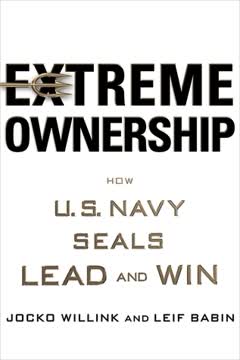






Download PDF
Download EPUB
.epub digital book format is ideal for reading ebooks on phones, tablets, and e-readers.
